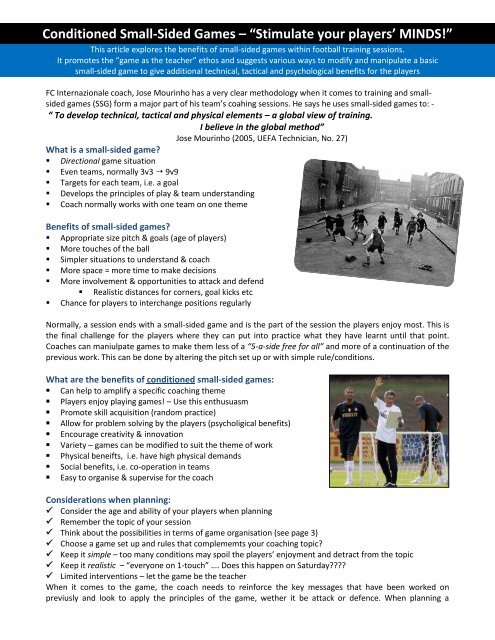Conditioned Small-Sided Games - NFP Soccer
Conditioned Small-Sided Games - NFP Soccer
Conditioned Small-Sided Games - NFP Soccer
You also want an ePaper? Increase the reach of your titles
YUMPU automatically turns print PDFs into web optimized ePapers that Google loves.
<strong>Conditioned</strong> <strong>Small</strong>-<strong>Sided</strong> <strong>Games</strong> – “Stimulate your players’ MINDS!”<br />
This article explores the benefits of small-sided games within football training sessions.<br />
It promotes the “game as the teacher” ethos and suggests various ways to modify and manipulate a basic<br />
small-sided game to give additional technical, tactical and psychological benefits for the players<br />
FC Internazionale coach, Jose Mourinho has a very clear methodology when it comes to training and smallsided<br />
games (SSG) form a major part of his team’s coahing sessions. He says he uses small-sided games to: -<br />
“ To develop technical, tactical and physical elements – a global view of training.<br />
I believe in the global method”<br />
Jose Mourinho (2005, UEFA Technician, No. 27)<br />
What is a small-sided game?<br />
Directional game situation<br />
Even teams, normally 3v3 9v9<br />
Targets for each team, i.e. a goal<br />
Develops the principles of play & team understanding<br />
Coach normally works with one team on one theme<br />
Benefits of small-sided games?<br />
Appropriate size pitch & goals (age of players)<br />
More touches of the ball<br />
Simpler situations to understand & coach<br />
More space = more time to make decisions<br />
More involvement & opportunities to attack and defend<br />
Realistic distances for corners, goal kicks etc<br />
Chance for players to interchange positions regularly<br />
Normally, a session ends with a small-sided game and is the part of the session the players enjoy most. This is<br />
the final challenge for the players where they can put into practice what they have learnt until that point.<br />
Coaches can maniulpate games to make them less of a “5-a-side free for all” and more of a continuation of the<br />
previous work. This can be done by altering the pitch set up or with simple rule/conditions.<br />
What are the benefits of conditioned small-sided games:<br />
Can help to amplify a specific coaching theme<br />
Players enjoy playing games! – Use this enthusuasm<br />
Promote skill acquisition (random practice)<br />
Allow for problem solving by the players (psycholigical benefits)<br />
Encourage creativity & innovation<br />
Variety – games can be modified to suit the theme of work<br />
Physical beneifts, i.e. have high physical demands<br />
Social benefits, i.e. co-operation in teams<br />
Easy to organise & supervise for the coach<br />
Considerations when planning:<br />
Consider the age and ability of your players when planning<br />
Remember the topic of your session<br />
Think about the possibilities in terms of game organisation (see page 3)<br />
Choose a game set up and rules that complememts your coaching topic?<br />
Keep it simple – too many conditions may spoil the players’ enjoyment and detract from the topic<br />
Keep it realistic – “everyone on 1-touch” …. Does this happen on Saturday????<br />
Limited interventions – let the game be the teacher<br />
When it comes to the game, the coach needs to reinforce the key messages that have been worked on<br />
previusly and look to apply the principles of the game, wether it be attack or defence. When planning a
conditioned game, the coach should give consideration to the following possibilites with regards pitch<br />
organsition and game conditions. Select the organisation that complememtns your coaching topic.<br />
Organisation Variations Examples<br />
Pitch size or shape Alter dimensions To suit topic, i.e. big pitch long passing<br />
Limited access areas<br />
<br />
<br />
Side channels<br />
Safety zones<br />
For wide players/crossers<br />
Areas where player can receives unopposed<br />
Full size goals + GK’s To suit topic, i.e. shooting<br />
<strong>Small</strong> target goals – no GK’s i.e. each team attacking 2 goals switching play<br />
Scoring method End zones (ful width) Pass or run the ball into?<br />
(Could be different at<br />
each end *)<br />
Additonal players<br />
Imposed conditions<br />
Corner zones i.e. a scoring zone in each corner of the pitch<br />
<br />
<br />
Gates (numerous)<br />
Triangular gates<br />
Where? How many? Pass or run ball through?<br />
Target players END of pitch How many?<br />
Servers END of pitch. How many?<br />
Neutral players /<br />
playmakers<br />
ON the picth. How many?<br />
Support players SIDES of pitch. How many?<br />
On players (some or all) i.e. man for man marking<br />
On the practice i.e. 1-touch finish only<br />
Example: A small-sided game for “Finishing Inside The Penalty Area”<br />
2v2 in each half + side support players
Some Possible Variations:<br />
Size / shape of field Channels or safety zones Full Size Goals + GK’s<br />
<strong>Small</strong> target goals (2 goals +) Scoring zones (end or boxes)<br />
T T<br />
GK<br />
Target players Neutral players Support players<br />
Combination of above * (example) Condition players<br />
(i.e. must overlap)<br />
<br />
<br />
<br />
<br />
<br />
<br />
N<br />
<br />
<br />
<br />
<br />
<strong>Small</strong> goals with scoring zones<br />
Neil Winskill | UEFA ‘A’ Coach<br />
Football Development Officer (Newcastle City Council<br />
Team Coach – Ashington Football Club<br />
GK<br />
S<br />
S<br />
GK


